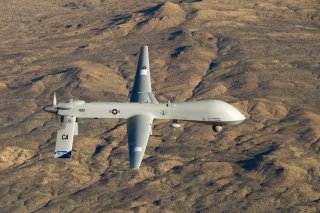Target Practice: Air Force Issues Call for New Stealth Training Drone
A new stealth drone would better prepare American pilots to face these Chinese and Russian stealth fighter aircraft.
To compete with advanced Chinese and Russian aircraft designs, the U.S. Air Force wants an expendable stealth drone that it can use for target practice.
The Air Force Life Cycle Management Center posted a Request for Information, providing details about a supersonic-capable Next Generation Aerial Target (NGAT). NGAT is an unmanned drone that can be used for target practice by pilots, as well as to test out missiles, radar, and other sensors.
The Request for Information acknowledges the threats posed by other great power competitors. While it does not mention any specific countries, it does highlight some of the capabilities of Chinese and Russian stealth fighter jets and makes it clear that the purpose of a new stealth drone would be to better prepare American pilots to face these two countries’ aircraft.
“Numerous and varied threats throughout the world, plus tighter defense budgets, drive the need for new and innovative solutions towards providing the NGAT,” the request said.
“The objective of this RFI is to determine the existence of sources that have the capability to design, integrate, build, test, manufacture and deliver an affordable aerial target that is threat representative.”
The target drone should behave as an adversary aircraft could reasonably be expected to behave, and proposals should “include provisions for Electronic Warfare (EW) equipment, Radio Frequency (RF) emitters, Electronic Attack (EA) capabilities and expendables such as chaff and flares. The target should be capable of providing adequate fidelity presentations of advanced adversary threat aircraft (J-20, Su-57, etc.) for specific test scenarios.”
The Request for Information explained that the stealth drone could be a brand-new design or a modification of previous drone designs.
“The solution may comprise either clean-sheet design, modification to previously-developed capabilities or both, focusing on mature technologies to minimize risk,” the request explained. “In considering a solution, the Government is interested in determining the feasibility of delivering 2-5 fully tested flying prototypes within 5 years of contract award.”
The request also noted that the advanced target drone, representative of a stealth fifth-generation aircraft, “should be able to provide a remotely controlled, destructible asset with threat representative RF Emissions, EA Emissions, Radar Cross Section (RCS) signature, Infrared (IR) signature, and internally carried expendables. Remotely-controlled targets must be capable of autonomous operation, either under remote control by a human operator, autonomously by onboard computers, or any combination of the two methods.”
The U.S. Air Force is feeling the heat and is keenly interested in ensuring its pilots can stay at the top of their game.
Caleb Larson is a multimedia journalist and defense writer with the National Interest. A graduate of UCLA, he also holds a Master of Public Policy and lives in Berlin. He covers the intersection of conflict, security, and technology, focusing on American foreign policy, European security, and German society for both print and radio. Follow him on Twitter @calebmlarson.
Image: DVIDS.

